
What is groundwater pollution
Groundwater pollution, in its essence, is the human-induced degradation of natural groundwater quality. This degradation primarily arises from the disposal of various types of wastes onto or into the ground. The pollutants responsible for this contamination span across organic (e.g., chlorinated phenoxy acid herbicides), inorganic (e.g., nitrate), biological (e.g., coliform bacteria), physical (color), and radiological (e.g., barium) categories.
Methods of Waste Disposal
The methods employed for waste disposal are diverse and include discharge into the sea and streams, placement in percolation ponds, on the ground surface (via spreading or irrigation), in landfills, and into disposal wells and injection wells.
Waste, in this context, encompasses all undesirable or superfluous by-products, emissions, residues, or remainders from any process or activity. It can be gaseous, liquid, solid, or a combination of these. For practical considerations, material becomes waste when it is committed to storage (lasting three months or longer), leaves the site, or enters the environment.
Principal Sources of Pollution
The major sources of groundwater pollution are categorized into:
Municipal: Involving sewer leakages and the disposal of liquid and solid wastes.
Industrial: Resulting from mining activities, tank and pipeline leakage, oil field brines, and liquid wastes.
Agriculture: Stemming from irrigation return flows, fertilizers, pesticides, and animal wastes.
Miscellaneous: Encompassing saline water intrusion, septic tank and cesspools, roadway deicing, and interchange through wells.
These sources can be further classified as point (singular location), line (with a linear alignment), or diffuse (occupying extensive areas) sources.
Objectives of Groundwater Pollution Investigation
The investigation into groundwater pollution serves various purposes, including:
Determining the extent of pollution by quantifying the amount of pollutants.
Identifying potential sources of pollutants impacting the groundwater regime.
Quantifying the contribution from different sources.
Studying the migration rate of pollutants through aquifers.
Modeling the local and regional movement of pollutants through aquifers and predicting future water qualities.
Proposing management strategies to minimize the influence of disposal.
Remedial Measures for Groundwater Contamination
Addressing groundwater contamination requires a range of remedial measures, such as:
Surface Water Control: Increasing runoff and reducing infiltration.
Groundwater Control: Sealing off lateral flow in shallow aquifers.
Plume Management: Lowering the water table below contaminants, utilizing scavenger wells to extract leachate, injecting to create a hydraulic barrier, and excavation for the physical removal of contaminants to a safe site.
The choice of the most appropriate or cost-effective remedial measure depends on factors like the extent of contamination, the type of contaminant (toxic or hazardous vs. conventional), whether the material is organic or inorganic, how tightly bound the contaminant is to the soil, and the hydrological setting.
Furthermore, it is emphasized that generators of hazardous waste should be held liable for damages resulting from the disposal of such waste, underscoring the need for responsible waste management practices.
